Ascending One of the World’s Oldest, Tallest Trees for Science and the Views
Since 2011, drought and pestilence have killed more than 100 million trees in California. What does that mean for the fate of the world’s largest tree, the giant sequoia?
By the time John Muir and his trusty mule Brownie splashed across the Marble Fork of the Kaweah River in the fall of 1875, the Scottish-born naturalist had already seen his fair share of California grandiosity: Yosemite Valley; the high Sierra; Mariposa Grove. Muir had a thirst for exploration and a talent for storytelling. He founded the Sierra Club and dubbed its synonymous mountains the “Range of Light.” When Muir sauntered upon a montane plateau in what is now known as Sequoia National Park on that autumn day, he found a very large stand of very large trees. Drawing his poetry from the obvious he named it, quite simply, the Giant Forest.
The dominant feature of the Giant Forest is the giant sequoia (Sequoiadendron giganteum), the biggest tree on Earth. Thousands of them grow in this 2,300-acre grove, including five of the ten largest specimens in the world. They reach heights of nearly 300 feet; their trunks can span more than 30 feet; and they’re nearly impossible to miss if you’re tromping beneath their canopy. “In every direction Sequoia ruled the woods…” Muir waxed in Our National Parks, “a magnificent growth of giants grouped in pure temple groves.” And yet, at 4:00 a.m. on a warm August morning, our hearty group of scientists and climbers is having a tough time finding the damn things.
“I feel like we’ve gone too far,” says forest ecologist Wendy Baxter, 36, stopping the group. The ivory glow of a full moon offers enough illumination to hike without fear of face-planting, but it makes for a poor navigational beacon.
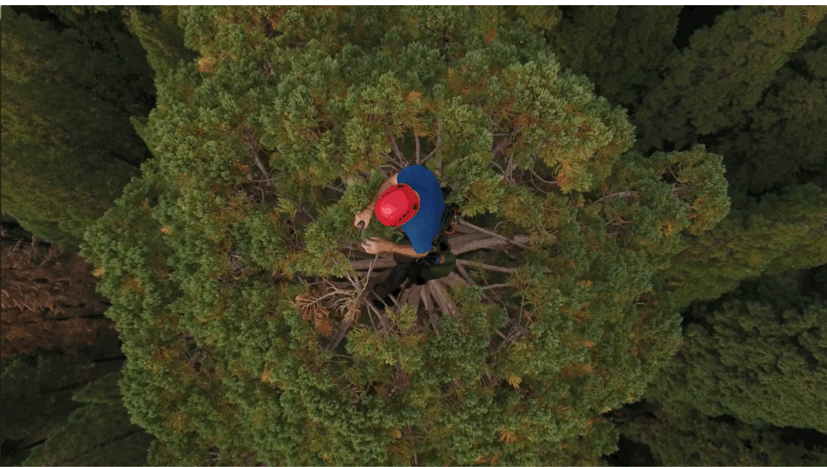
It’s the fourth day of two weeks of fieldwork led by Baxter and fellow forest ecologist Anthony Ambrose. Scientists at UC Berkeley’s Dawson Research Lab, the two are part of Leaf to Landscape, a program in collaboration with the United States Geological Survey, the National Park Service, and the Carnegie Airborne Observatory, that is focused on studying and managing the health of the giant sequoias.
California, of course, is in the middle of a historically punishing drought at a time when there’s never been more demand for water. According to the United States Forest Service, 62 million trees have died in California this year alone. Since 2011, a total of 102 million trees have perished, with tens of millions more on death’s doorstep. California’s forests generate fundamental ecosystem services by creating healthy watersheds, providing wildlife habitat, and sequestering atmospheric carbon, and they’re dying at unprecedented rates. Even the great giant sequoias are showing concerning signs of stress. It’s Ambrose and Baxter’s goal to collect and analyze tree samples to understand how the sequoias are faring under these rapidly changing conditions, and what might be done to protect them. But first we have to find them.
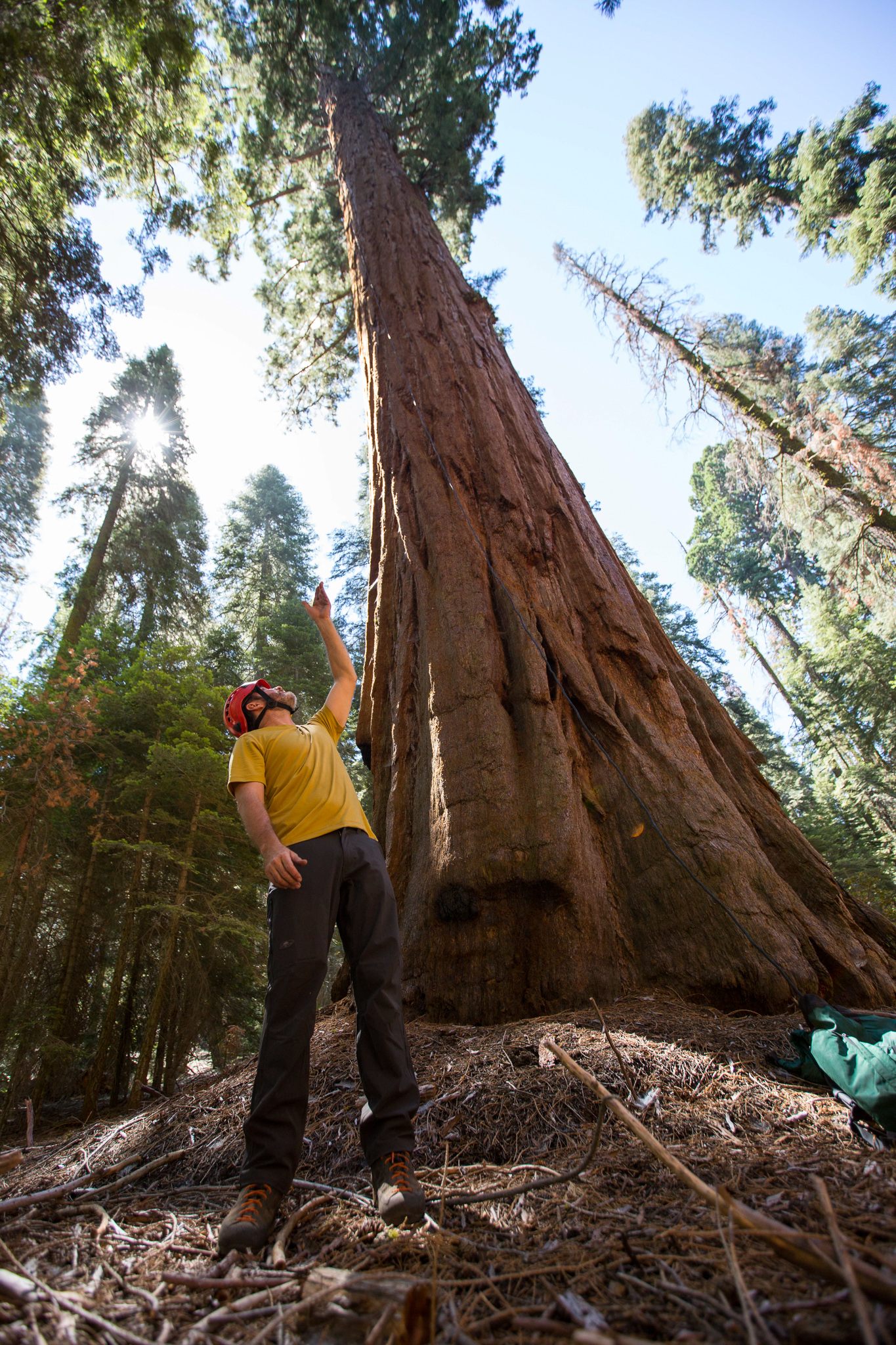
“Have we come to any intersections at all?” asks Ambrose, 48, whose attention has been focused on answering my questions instead of spotting landmarks.
“I remember this tree, for sure,” someone chirps, a sentiment that seems more appropriate as an epitaph on a lost hiker’s headstone than as a vote of directional confidence. After a brief parley, we correct our course up a gentle rise, down into a shallow basin, and past a pair of landmarks, unmistakable even at this dark hour.
The path splits twin sylvan towers standing inches apart and hundreds of feet tall. It’s still too dark to marvel at their height, but the base of each tree inspires awe enough, gnarled and bulbous and swelling with woody knuckles the size of a Toyota Prius. A few hundred yards farther, the trail continues through the hollowed-out center of another sequoia. Fire, the great creator and destroyer, Kali of the Giant Forest, raged here long ago, burning out the tree’s core. The wound is enormous, 40 feet tall or more and nearly the size of the tree’s entire 12-foot diameter. Yet the grand monarch survived the blaze, which also would have cooked off the thick layers of duff that choke seedling growth, offering tiny sequoias a chance to one day touch the sky and survive their own infernos.

The group splits apart at the meadow, each climber heading to the tree they’ll be sampling. The scientists have targeted 50 sequoias for study—“the biggest, gnarliest trees in the forest,” Ambrose says—and this morning he’ll climb a 241-footer. In most other forests a tree like this would be a star attraction with an honorific name and perhaps even a viewing area. Here, it’s simply known as “tree 271.”
Ambrose has striking blue eyes and wears a woodsman’s beard with a chinstrap of white whiskers. He slides on his climbing harness and tugs the rope anchored to the crown some 24 stories above. He’s been studying trees for more than two decades, first with a focus on coast redwoods (Sequoia sempervirens) as an undergraduate and master’s student at Humboldt State University, and then on giant sequoias for his doctoral and post-doc work at Berkeley. “From an aesthetic perspective to a biological one, these trees are some of the most spectacular organisms on the planet,” he says with the enthusiasm of a boxing promoter. “They are the pinnacle of what a plant can become. They force you to think about life and your own place in it.”
He clips on a pair of jumar ascenders—mechanical devices that attach to the rope and allow him to pull himself up. “You can’t really understand the true character of a tree from the ground,” he says. Ambrose turns off his headlamp, cranes his head toward the canopy, and begins the long, dark climb into a world of mystery.

The giant sequoia has dominated its landscape for millions of years and captivated global imagination since the mid-19th century when rumors of trees the size of fairy-tale beanstalks came roaring out of the Sierras. One of four redwood species, the giant sequoia is not the world’s tallest tree; that crown belongs to its northern cousin, the coast redwood. But in terms of sheer volume of biomass, no living organism ever to walk, swim, fly, or stand on this planet comes close. They are of such stature that people struggle to describe them and so compare them to other very big things: blue whales, 747s, dinosaurs, the Statue of Liberty, elephant herds, space shuttles. Giant sequoias make mice of them all.
More than 100 million years ago, when the planet was warmer and wetter, the sequoia’s earliest relatives thrived across much of the Northern Hemisphere. Redwood fossils have been found everywhere from Northern Mexico and the Canadian Arctic to England. During the late Miocene, some 10 to 20 million years ago, the closest direct ancestor of the giant sequoia lived in what is now southern Idaho and western Nevada. As the Sierra Nevada Mountain Range continued its uplift and the climate became drier, the giants’ range shrank. Today, the last remaining sequoias are limited to 75 groves scattered along a narrow belt of the western Sierra Nevada, some 15 miles wide by 250 miles long.
Giant sequoias are among the longest-living organisms on Earth. Though no one knows the trees’ absolute expiry date, the oldest ever recorded is 3,200 years old. Muir claimed to have found a stump with 4,000 tree rings, one per year. During their early years the trees are subject to predation and the volatile whims of nature. Once they reach adolescence after a few centuries, however, sequoias become well-nigh indestructible. Their bark is soft and fibrous and contains very little pitch, qualities that make the trees extremely resistant to fire. The tannins that give their wood a rich cinnamon hue also repel insects and fungi.

When a mature sequoia does die, mortality is usually a function of its marvelous size. Root rot can deprive a tree of a solid anchor and fire can undermine its base, but rarely will either actually kill a 30-story monarch. Gravity is the ultimate culprit, for a giant sequoia with an uncertain foundation faces a violent and certain end. The persistent tug of gravity can pull an unbalanced tree to the forest floor with such a thunderous crash that the reverberation can be heard miles away. The sequoia’s fate is an Icarian allegory, met not by flying too close to the sun, but by stretching too far from its roots.
Thanks largely to their ability to withstand disease and drought, it’s extremely rare for a giant sequoia to die standing upright. “You don’t get to be 2,000 years old without surviving a few dry spells,” Ambrose tells me. Which is exactly why United States Geological Survey forest ecologist Nate Stephenson was so alarmed when, in September 2014, he went for a walk in the Giant Forest and saw something unexpected.
“I had been saying with confidence for decades that if you hit a big drought, the first signs of climatic changes would show up in seedlings,” recalls Stephenson, who has studied trees in Sequoia and Kings Canyon National Parks since 1979. “I was completely wrong.”

He surveyed an area that had burned a few years prior, where seedlings had taken root. Crawling around on his hands and knees, Stephenson was surprised to see that the seedlings were rigid and full of water, their leaves a vibrant blue-green. This was the third year of drought in California, and the summer of 2014 was particularly brutal. There should be some evidence of drought stress, he thought. Sitting on the ground, he leaned back, craned his head toward the heavens to ponder the mystery, and found his answer.
Above him stood a grand old monarch. The crown of the tree was almost entirely brown, a scale of dieback he’d never seen. He searched for other trees displaying similar stress and when he found one with branches close to the ground, he touched it. The foliage crumbled off. In more than 30 years of studying these trees Stephenson had only seen two die on their feet. Five years into the current drought, he’s now seen dozens of standing dead.
Stephenson quickly assembled a team to survey the 2014 dieback before autumn storms could blow away the evidence. The National Park Service (NPS) enlisted Ambrose and Baxter to begin their fieldwork in 2015. While the NPS and scientists working in Montana’s Glacier National Park might already be resigned to a glacier-free future as the climate changes, no one is ready to consider the possibility of Sequoia without its namesake trees.
“HEADACHE!!!” AMBROSE YELLS.
His warning, the tree-climbing vernacular for plummeting deadfall, fills the forest moments before a branch whooshes passed, inches from my head. It happens so quickly, the broken limb has already hit the ground before I have a chance to move.
“And that’s why we wear helmets when we work around trees,” he explains to the small group of us standing at the base of the sequoia.
The lessons come quickly on our first day of fieldwork. We set up on a steep hillside and Baxter demonstrates how to prepare the rigging for a climb. Tall and lean with a strong jawline and a soft voice, she’s as comfortable doing stable isotope analysis in the lab as she is setting a 600-foot static line in a tree. “I love the combination of physical exertion and intellectual stimulation,” she tells me. “It’s a struggle to get to the top of the tree. You’re sweating and huffing and puffing, but that’s when you start collecting your samples and the science begins.”
In 2015, Baxter and Ambrose did much of the work themselves, identifying and rigging 50 trees, making six climbs a day, and collecting samples and measurements from each one. Their days began at 2:30 a.m. and ended at 10 p.m.—if they were lucky. “That was brutal,” Baxter recalls.
They have more help this time around. Over the course of two weeks, more than a dozen volunteers—students, professional arborists, climbing junkies—will rotate in and out. The schedule, while not nearly as frantic as the previous year, is aggressive. We wake up at 3 a.m. and begin our hike from the Crescent Meadow parking lot into the Giant Forest an hour later. After climbing trees and taking and analyzing samples all day, we head back to our campground for some R&R before collapsing into bed.

The immediate goal is to understand the severity of water stress the trees are facing, the water content in the leaves, and the amount of the stable carbon-13 (13C) isotope the tree uses during photosynthesis, which offers additional insight into how the trees are coping with drought. With that information, scientists and park officials can assess the trees’ health and begin to think about ways to protect giant sequoias through practices like controlled burns, which clear the ground for seedlings and eliminate less fire-resistant trees that compete for water.
Ambrose’s first exposure to forest management came as a wildland firefighter following his senior year of high school in Chico, California. The experience, he recalls, involved “hours of boredom followed by long stretches of terror,” and gave him a first-hand look at how a policy of aggressive fire suppression can have an adverse effect on forest ecosystems.
For more than a century, the government’s approach toward forest fire has been one of suppression. But indiscriminately stamping out frequent, less intense, naturally occurring fires disrupts the natural process of consumption and rejuvenation that species like giant sequoias need to thrive. It also allows dangerous levels of fuels to pile up—until one explosive holocaust vaporizes everything. “You get these large landscape conversions, conifer forests turning into brush,” Ambrose says.
In 2013, the Rim Fire swept through the Sierras, consuming more than 257,000 acres. It was the third largest fire in California’s recorded history and burned for 15 months. It never reached Sequoia National Park, but it did sweep through parts of Yosemite some 100 miles north. As a precautionary measure, officials even set sprinklers around of some of Yosemite’s giant sequoias in case the fire got too close.

Giant sequoias, like all trees, play a central role in the hydrologic cycle. Storms drop rain and snow, which giant sequoias can chug to the tune of 800 gallons per day—more than any other tree. As the trees draw water out of the ground, the air surrounding the leaves draws water through the trees and, eventually, back into the atmosphere. That process, called transpiration, creates tension within the tree’s water columns. The drier the atmosphere and the less groundwater available, the higher the tension. Under extreme drought conditions, when that tension grows too high, those columns of water can snap like a rubber band. Gas bubbles form, creating an embolism that prevents the flow of water up the trunk. If this happens enough, a tree will shed its leaves and can, eventually, die.
To measure water tension and other biological processes, climbers sample each tree twice a day, once under cool pre-dawn conditions when the tree is least stressed, and once under the heat of the midday sun. The scientists clip foliage from the lower and upper canopies, which allows them to assess conditions at different parts of the tree.
After the safety talk and rigging demonstration, Ambrose grabs a laminated map from his pack and assigns the climbers to their trees. Pulling on a forest-green arborist harness, he clips a pouch onto each hip to carry his samples. Then he steps into the foot straps attached to the ascenders and begins the climb.

His arms, legs, and core work in an assembly line of movement. Hanging on the rope in a crouch, he slides his right arm up, follows with his left, pulls his knees to his chest, and stands up straight in the stirrups, at which point he repeats the routine—scores of times on his way to the top. Climbers call it “jugging,” a process as onomatopoeically laborious as it sounds.
About 100 feet up, Ambrose stops at the lower canopy, marked by the first significant limbs, which can grow up to six feet in diameter. He clips a handful of tiny branches, puts them into a plastic bag, shoves the bag into his hip pouch, and continues climbing. The tree’s leaves regulate gas exchange through tiny pores called stomata. The stomata take in carbon dioxide and release oxygen and water vapor. When a tree becomes too water-stressed it closes its stomata. This stops water loss through transpiration but also prevents the tree from absorbing atmospheric carbon dioxide and using it for photosynthesis. Sequoias have vast carbon stores to help them weather these lean times, but if the stomata stay closed for too long, the trees will eventually starve to death.
As Ambrose works in the tree, I take a short hike up to the top of a hill just above the study site, where the cost of California’s drought reveals itself in spectacular panorama. The Middle Fork of the Kaweah River plummets from the high Sierra into the agricultural empire of the San Joaquin Valley. Polished granite swells and the jagged sawtooth mountains of the Great Western Divide dominate the horizon; pine, fir, and cedar trees blanket the river basin. The colors are rich and electric, but they don’t all sit right. In a sea of green, huge islands of red metastasize across the landscape. These ochre forests are not sequoia. They are thousands and thousands and thousands of dead trees.

Numerically speaking, giant sequoias constitute a small portion of California’s forest. A few weeks before my foray with Ambrose and Baxter, I hopped on a survey flight with Greg Asner, principal investigator at the Carnegie Airborne Observatory (CAO), to get a better understanding of what’s happening to trees across the entire state and what that might indicate for the future of the sequoias.
Asner, 48, runs a flying laboratory called the Airborne Taxonomic Mapping System, a Dornier 228 airplane tricked out with $12 million of custom-built equipment that allows the CAO to measure the composition, chemistry, and structure of a forest in detail and efficiency that, not long ago, was relegated to the realm of science fiction. “In California,” said Asner, “we have exact numbers on 888 million trees.”
We met at 7:30 a.m. at Sacramento’s McClellan Air Park. Dressed in snappy black flight suits, Asner and his four-man team were going through last-minute checks and waiting for the sun to climb higher in the sky, which would allow for more accurate measurements. The goal for the day: map a 3,600-square-mile section of northern California forest.
Collecting such voluminous amounts of detailed data requires a unique toolbox. The plane itself is geared toward special mission work with its high-payload capacity and short takeoff and landing capabilities. An imaging spectrometer, resting atop a hole cut in the belly of the plane, absorbs light across the spectrum, from ultraviolet to short-wave infrared. It allows the CAO to measure 23 different chemicals in the trees, including water, nitrogen, and sugar content. To work properly, internal sensors within the imaging spectrometer are kept at -132 Celsius, atomically cold temperatures.

A laser system next to the imaging spectrometer fires a pair of lasers from the bottom of the plane 500,000 times per second, creating a three-dimensional image of the terrain below, and every tree on it. A second spectrometer, this one with an enhanced zoom capacity, allows the team to take measurements of individual branches on a tree—from 12,000 feet up. Finally, a piece of equipment known as an Internal Measurement Unit records the X,Y, and Z axes as well as pitch, roll, and yaw of the plane to ensure that its positioning in the air doesn’t compromise the accuracy of the data it collects from the ground. “This unit is the same technology as what’s in the nose of a cruise missile,” Asner explained. “Because of that, the State Department has a say in what countries we visit.” The CAO studies forests all over the world—Peru, Malaysia, Panama, South Africa, Hawaii.
Once airborne, we dismissed the sprawl of the Central Valley for the coastal mountains. To the naked eye, the Shasta-Trinity National Forest looked splendorous, 2.2 million acres of rivers and mountains. Mount Shasta, a 14,179-foot active volcano, was still holding on to a handsome cap of snow and the landscape was vibrant and green. Asner’s spectrometer shared a different story. “Visual assessment doesn’t tell you much,” he said. On his computer screen, the green trees below were all reading red. They were dead. We just couldn’t see it yet. “A lot of this was not here last year,” he said with the clinical efficiency of a doctor diagnosing a cancer patient. CAO’s statewide findings suggest tens of millions of trees might not survive another dry winter.
Sugar pine (Pinus lambertiana), a species that grows in large, contiguous groves and can live 500 years, has been hit the hardest, accounting for some 70 percent of the mortality, but cedar, fir, and oak are all suffering as well. It’s not just the lack of precipitation that’s killing these trees; it’s the cascading effect of climate change. Water-stressed trees make easier targets for mountain pine beetles (Dendroctonus ponderosae), which lay their eggs in the trunk and eat the trees.
Asner shared a map of the Giant Forest. The sequoias were a cool, comforting shade of blue, demonstrating high water content. Water seeks its low point, Asner explained, and the Giant Forest sits in a plateau cup. “It’s an oasis, a refugio. Right now, those trees are of least concern.” It was bittersweet news, like celebrating the last house standing after a tornado.
“Drought is a cumulative process,” Asner explained as the plane made a long bank off the western slope of Shasta. “Forests have biological inertia. We don’t know where the physiological tipping point is. Currently, we’re losing carbon from the forest.”
Forests are supposed to absorb carbon, so I wasn’t sure if I’d heard Asner correctly over the communication system. I tapped my headphones to make sure they were still working. “I’m sorry, did you just say the forests are releasing carbon into the atmosphere?” Automobiles, coal-fired power plants, cattle production—those are all carbon sources. But the mighty forests of California?
“That’s my guess,” he said. “It’s hard to imagine the forests are still carbon sinks.”

Of the hundreds of feet it takes to climb to the top of a giant sequoia, the first six are invariably the most difficult.
After two days on the ground watching the rest of the team sliding up and down the sequoias, I ask Ambrose for a tutorial. Over the years, I’ve spent enough time on rock and rope to scratch my way up a 5.10, but tree climbing—beyond the scampering variety, anyway—is new territory.
It looks easy enough. Ambrose has been powering into the canopy in minutes, and Baxter has a fancy one-legged technique that looks like she’s hopping on air. I, meanwhile, can barely get 12 inches off the ground. Those charming fire caves that serve as a window to ancient battles? They’re actually hazardous overhangs that cause a climber to pendulum into a cavern of charred pith. The two feet of duff piled up on the root system? That makes it just hard enough to get the clearance from the tree trunk needed to begin a comfortable climb. I’ve never done the splits, but with my feet strapped into the stirrups I find myself spinning, spread-eagled in endless, dizzying circles. Then I sprain my knee.
If Ambrose and Baxter climb their ropes like graceful inchworms, I look like a marionette having a seizure. Eventually I reach the lower canopy but my knee feels like a water balloon in a pressure cooker and I’m a long way from mastering Baxter’s hop-along trick. I descend in the interest of doing more climbing later in the week.
Back on the ground, I limp over to Ambrose and tell him of my failed attempt. “It’s tricky the first time. You want to avoid gripping the ascenders too tightly. And really, you shouldn’t be using your upper body very much at all. You mostly want to use knees and core.” Translation: The exact opposite of what I was doing.

A few days later I get my chance on another pre-dawn climb. The tree is one of the largest individuals in the world—220 feet tall and 20 feet in diameter at the base—all the more impressive considering it’s growing in shallow soil atop a plate of granite. Underground, the tree’s been waging war with its rocky substrate for millennia, its roots probing every crack and fracture in a tireless search for water. I clear the first few feet without issue and begin the long journey to the top.
The sequoia is shaped like a giant barrel, tall and fat with hardly a taper. For the first ten stories, the trunk is a sheer wall of wood with an uninterrupted profile. I pass the crown of a neighboring 90-foot pine before even reaching the first branch of the sequoia. As I enter the sprawling branch network of lower canopy, the climb shifts from a smooth glide to a bruising slugfest. I work my way over, around, and between branches, each the size of a normal tree. About half way up, a pair of branches five feet thick shoots out from opposite sides of the trunk and up in an L-shape, like two arms flexing in a proclamation of strength.
Finally, the top. After 40 minutes of climbing, I take a seat to catch my breath. The crown is gargantuan. On one side a half dozen branches converge to create a bench wide enough for a square dance. It’s easy to get lost in the scale, but as my heart slows and the morning brightens, the subtleties stand out. Thousands of green cones the size of ping-pong balls hang from the branches like chandeliers. Unlike the lower sections of the tree, the bark here is smooth and seamless with a purple tint, and etched with fine lines like topographic contours. A menorah of knobby vertical branches, called reiterated trunks, sprouts out of the crown. I scamper up the last 10 feet and perch on the stumpy tip of one of the spires.
The crowns of sequoias punctuate the tree line like bushy, green exclamation points. Surrounded only by a warm breeze and empty space, I find myself completely exposed and suffering through an emotional paradox. There’s freedom up here with the birds, a glorious release from anything familiar. But it’s a narrow liberty. The laws of gravity and my seismic discomfort of heights dissuade me from any spread-eagle “I’m King of The World” moments. A western tanager (Piranga ludoviciana) lands on a branch and swivels its bright red head toward me, confused by the interloper in its realm. On the forest floor, a black bear (Ursus americanus) lumbers about for breakfast. More people have summited Everest—more people have probably walked on the moon—than have stood atop this noble tree.
“There is absolutely no limit to its existence,” John Muir wrote of the sequoia in Our National Parks. “Nothing hurts the big tree.” The sunrise, however, reveals an unsettling future. Even here, in the country’s second-oldest national park, the horizon is the sickly yellow of a cigarette butt, a vaporous mixture of Central Valley smog and forest fire smoke from the myriad infernos burning across the state.
Muir’s hyperbole is understandable. The tree I’m sitting atop probably took root before Athenian democracy sprouted in ancient Greece. It has lived through the rise and fall of many of the world’s great civilizations, from Romans to Mayans to the British Empire. Its long shadow has fallen over this forest for three millennia, but that can’t obscure the exhaust of human progress. As I clip my climbing descender onto the rope and begin the journey to the forest floor, I can’t help but wonder: Will this tree stand long enough to witness our own fall? Or will it fall first?
A version of this story originally appeared on bioGraphic.com.


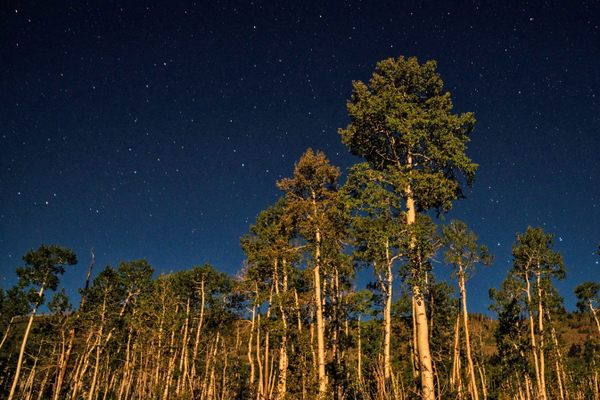
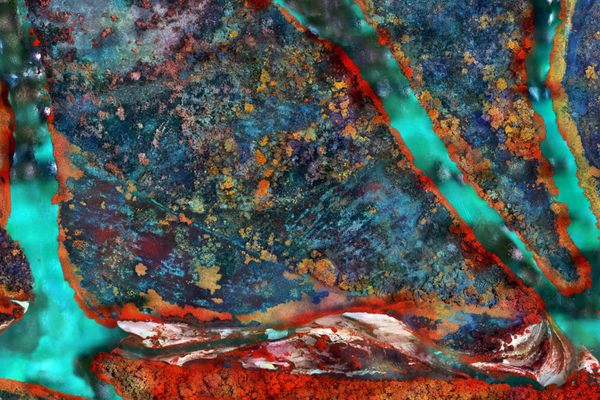


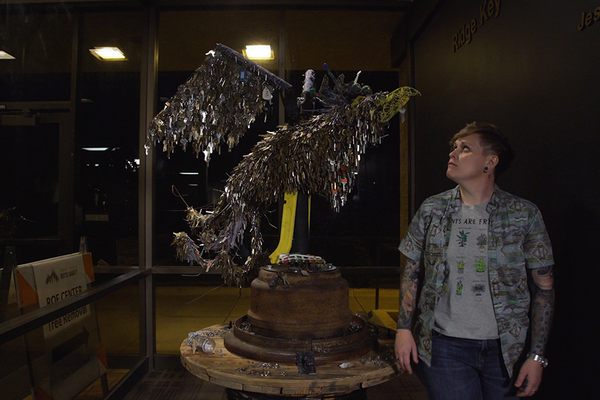



















Follow us on Twitter to get the latest on the world's hidden wonders.
Like us on Facebook to get the latest on the world's hidden wonders.
Follow us on Twitter Like us on Facebook